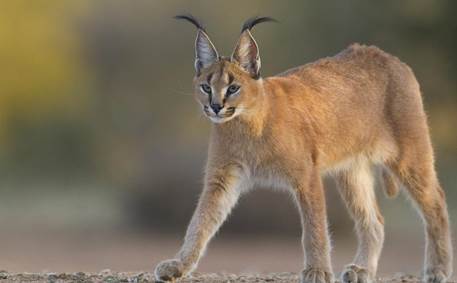Description

Copyright infringement not intended
Context: The cheetah is returning to India today after seven decades. But the caracal, which was used by India’s nobility in the sport of coursing like the cheetah, is struggling to survive, although both species had a similar distribution in the past. A team of researchers have now mapped out the most suitable areas for the species to survive in India.

Details:
- The Asiatic caracal (Caracal caracal schmitzi) is an elusive medium-sized and locally threatened felid (cat) species, which has been widely reported to be on the brink of extinction in India.
- The reasons are large-scale hunting, illegal trading and loss of natural habitats are considered significant threats to the species.
- The caracal is currently included in Schedule I of the Wild Life (Protection) Act, 1972 and the Near Threatened category by the Conservation Assessment and Management Plan and International Union for Conservation of Nature Red list assessment in India
- The researchers found the most significant potential habitat for caracals in Rajasthan, with an area of 25,221.38 square kilometres, followed by Gujarat (16,652.1 sq km), Madhya Pradesh (6416.01 sq km), Haryana (191.36 sq km), Uttar Pradesh (131.11 sq km), and Maharashtra (34.17 sq km).
- The most suitable areas for caracals on the district level were found to be in the Kutch district of Gujarat; Sheopur, Morena, and Shivpuri of Madhya Pradesh and Sirohi, Jalore, Alwar, Karauli, Sawai Madhopur, Kota, Dhaulpur, Bundi, Baran, Jaipur, Tonk and Dausa of Rajasthan.
- The most suitable habitat for caracals in Rajasthan, Gujarat and Madhya Pradesh is located in Kutch, the Malwa Plateau, the Aravalli hill range and the Bundelkhand region, according to the researchers.
- They also noted that large amounts of caracal suitable habitats in India fell within protected areas, thus providing an excellent opportunity for its conservation in the already existing management and conservation setup.
- The protected areas which provided high conservation potential for caracals included Kachchh Wildlife Sanctuary (WLS) in Gujarat, the tiger reserves of Ranthambhore, Mukundra hills and Sariska and the WLS of Kumbhalgarh, Mount Abu and Todgarh-Raoli in Rajasthan, as well as Gandhi Sagar WLS in Madhya Pradesh.
- The caracal was the only other feline which was used for hunting in India.
- Just when it came to be so used is unclear but it is known that Firoz Shah Tughlaq had many of them in his hunting establishment and it was well established in the Mughal Court for Abul Fazl records that Akbar was very fond of using this plucky little animal for hunting purposes…” author Divyabhanusinh noted in his book, End of a trail: The Cheetah in India published in 2006.
- He added that the animal had no Hindi or Urdu name but was known in India by its Persian name of Siyahgoshor ‘black ears’.
- The Saidnamah-i-Nigarinmanual from the Bundela Rajput princely state of Ajaigarh in Central India records that the caracal can be trained to hunt squirrels as well as birds such as kites, cranes and crows. It can also be trained to hunt animals far larger than itself such as the cheetal, the barasingha and the nilgai.
- In 2021, the National Board for Wildlife and the Ministry of Environment, Forest and Climate Change included Caracal in the list of Critically Endangered species under critically endangered species recovery programme.
https://www.downtoearth.org.in/news/wildlife-biodiversity/caracal-as-the-cheetah-returns-to-india-researchers-map-out-most-suitable-areas-for-its-coursing-counterpart-84959












